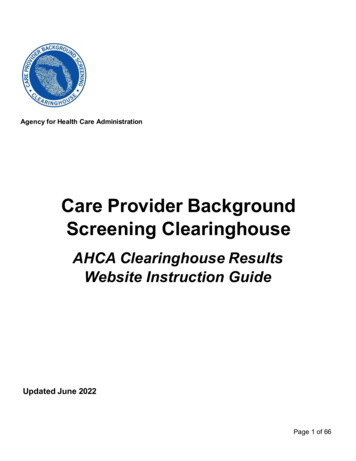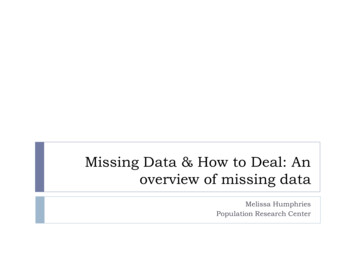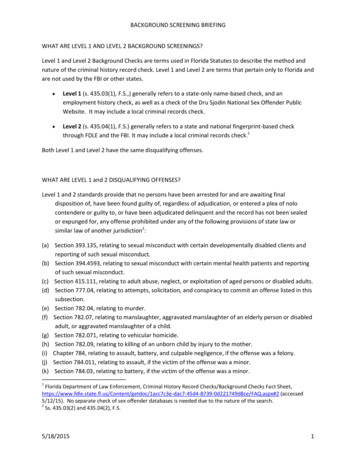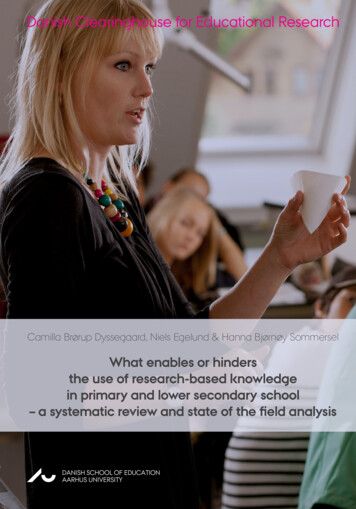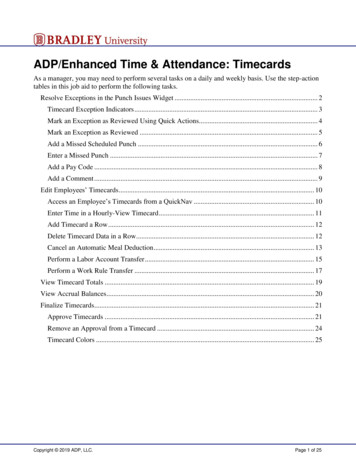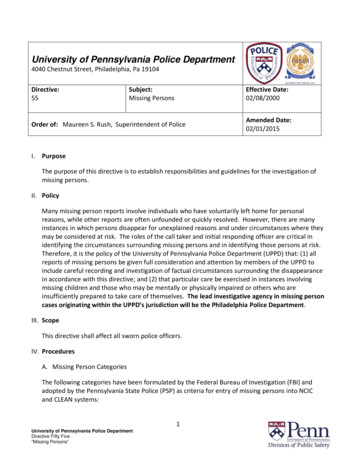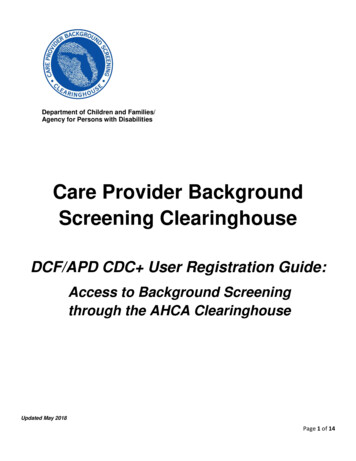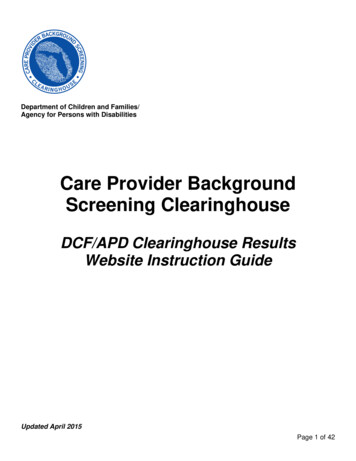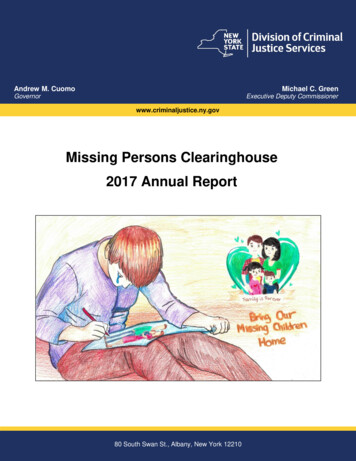
Transcription
Andrew M. CuomoMichael C. GreenGovernorExecutive Deputy Commissionerwww.criminaljustice.ny.govMissing Persons Clearinghouse2017 Annual Reporti80 South Swan St., Albany, New York 12210
New York State Missing Persons Clearinghouse2017Annual Reportwww.criminaljustice.ny.govThe New York State Missing Persons Clearinghouse is located within the New York State Division ofCriminal Justice Services (DCJS).The Clearinghouse operates in accordance with New York State Executive Law Sections 837, 837e, 837-f, 837-f-1 and 838; New York State Codes, Rules and Regulations Part 6055; and New YorkState Education Law Sections 355, 6206, 6303 and 6450.This report is submitted as required by Section 837-f-12 of the New York State Executive Law.On the CoverDesigned by Saranika Chakraborty of Elmhurst in Queens County, this poster was chosen from arecord 307 entries to represent New York in the National Missing Children’s Day Poster Contest, acompetition for fifth-graders sponsored annually by the U.S. Department of Justice. In addition tosubmitting a poster, students were required to explain why they created their poster. Saranika wrote:“Children should be safe at home and not have to worry about danger. I hope no one has to ever beor feel like the boy (in my poster).”Second Place was awarded to Jason Rowe of Elba in Genesee County, and third place to HannahHollenbeck of Odessa in Schuyler County.New York and other states annually coordinate their own contests, the winners of which competeagainst each other in the national competition, which is designed to raise awareness about missingchildren cases across the country. The Missing Person Clearinghouse coordinates New York’scompetition. National Missing Children’s Day has been marked annually on May 25 since 1983.Issued April 2018
Overview of Activities1Data Overview Missing Children4 Missing Vulnerable Adults5Services Investigative Support6 Training7 Alert Programs8Activity and Data Cases Received, Publicized, Closed and Birth and School Records Updated11 Alert Requests and Activations11 Annual Reporting Volume for Missing Children: 2005-201612 Characteristics of Cases Entered for Missing Children13 Characteristics of Cases Closed for Missing Children14 Length of Time on the Register for Missing Children15 Reporting Volume by County for Missing Children16 Reporting Volume by County for Missing Vulnerable Adults18 Days between Case Entry and Cancellation for Missing Vulnerable Adult Cases20 Missing Child Alert Activations and Resolutions21 Missing College Student Alert Activations and Resolutions22 Missing Adult Alert Activations and Resolutions23ii
Overview of 2017 ActivitiesIdentification of Unidentified Patients Model PolicyThe New York State Missing Persons Clearinghouse partnered with the state Department ofHealth to provide hospital administrators with an Identification of Unidentified Patients ModelPolicy distributed to hospitals throughout New York in January 2017.Clearinghouse staff developed the policy after recognizing that hospitals lacked a standardizedprotocol for admitting and assigning a temporary name to unidentified patients. This resulted inhospitals sometimes admitting missing adults with Alzheimer’s disease or other cognitiveimpairments without notifying police agencies or checking to see if the unidentified patient wasthe subject of an alert. As a result, these patients were sometimes not located as quickly, thuscausing further trauma to the individual’s family.Clearinghouse staff and Health Department officials convened a panel of experts to develop themodel policy. Representatives from Albany Medical Center, Albany Memorial Hospital, GreaterNew York Hospital Association, the state Division of Criminal Justice Services, the state Officeof Alcoholism and Substance Abuse Services, the state Office of Mental Health and the SamuelStratton VA Medical Center came together to develop the policy.The goal of the policy is to provide hospital administrators throughout the state with a consistentprotocol when admitting an unidentified patient into a hospital. Also, to have hospitals employ astandardized process for responding to requests for information from police and family membersseeking individuals who are missing.Key components of the model include: A standardized procedure for hospital record keeping and temporarily naming anunidentified patient. Guidance on the steps to take to identify the patient. The federal and state laws that allow hospitals to disclose information to lawenforcement when dealing with a missing/unidentified person case. Definitions of key terms used in the policy that are helpful when implementing theprotocol. Administrative action to be taken after a patient is identified.The model policy includes a standardized basic protocol that medical facilities can easilyimplement to identify unknown patients and lessen the trauma and anxiety families oftenexperience when searching for a missing loved one. The policy can be accessed here.New Missing and Unidentified Person Case Management SystemWorking in partnership with the state Office of Information Technology Services, theClearinghouse enhanced its case management database by implementing the first phase of a1
new centralized automated missing and unidentified persons tracking system. The system willwork in an online portal that is integrated with other missing and unidentified person databasesystems to streamline work flow, improve data quality and provide for more stable and accuraterecord keeping. The system will also provide case managers an improved way to disseminateinformation about missing individuals and maintain contact with their family members.The second phase –expected to be completed in summer 2018 –will include a tip/leadmanagement system and an enhanced flagging process for birth and school records of missingchildren. The new management system will allow the Clearinghouse to better document andcoordinate tip and lead information with the investigating law enforcement agency.The Clearinghouse is statutorily required to flag birth and school records of all missing childrenwho were born in New York State or attended school in New York state at the time the childwent missing. Records are flagged within 30 days of the missing child case being entered intothe statewide registry, or immediately for those cases involving abductions. If a person attemptsto obtain the missing child’s birth certificate or school record, vital records or school personnelimmediately notify the Clearinghouse and provide the persons contact information. Thatinformation is then passed on to the investigating agency. The person requesting to obtain therecords is never aware that the record has been flagged.Project Lifesaver TrainingThe Missing Persons Clearinghouse partnered with the Suffolk County Sheriff’s Office and theNew York State Department of Homeland Security and Emergency Services in Oriskany toprovide several Project Lifesaver refresher courses. More than 55 law enforcement officers from28 partner agencies participated in the training.Project Lifesaver is a radio frequency tracking program that allows individuals to wear a wrist orankle bracelet containing a transmitter that emits a unique tracking signal. If an enrolledindividual goes missing, the caregiver notifies a participating law enforcement agency, whichthen dispatches a trained emergency team to the area. Most individuals who wander are foundwithin a few miles from home and the tracking devices can reduce search time from hours ordays to minutes.In 2015, New York State partnered with Project Lifesaver International, providing life-savingequipment and training for law enforcement agencies to assist in missing child searches. Thestate provided agencies with nearly 600 Project Lifesaver tracking devices at no cost to bedistributed to children under 18 with autism, Down syndrome or another type of cognitiveimpairment that puts them at risk for wandering or becoming lost. The transmitters, which areworn on the wrist or ankle, emit a tracking signal that allows a child to be located quickly aftergoing missing.The state purchased the technology using approximately 253,000 from its Missing andExploited Children Special Revenue fund, which must be used exclusively to enhance servicesprovided by the Clearinghouse in connection with cases involving missing children younger than18. Parents and guardians can contact the law enforcement agency in their county to see if theirchildren are eligible for a free transmitter.2
The tracking technology is available from sheriffs’ offices in the following counties: Albany,Broome, Cattaraugus, Cayuga, Chautauqua, Chenango, Clinton, Columbia, Cortland,Delaware, Erie, Essex, Franklin, Fulton, Greene, Genesee, Hamilton, Herkimer, Jefferson,Madison, Montgomery, Niagara, Oneida, Onondaga, Ontario, Orange, Oswego, Otsego,Putnam, Rensselaer, Rockland, Saratoga, Seneca, Schenectady, Schoharie, Schuyler, St.Lawrence, Steuben, Suffolk, Sullivan, Tompkins, Ulster, Warren, Washington, Wayne,Westchester and Yates. The Nassau County Police Department also offers the technology.Go to www.projectlifesaver.org for more information on the program.Other ActivitiesThe Clearinghouse assisted the U.S. Department of State in 2017 with 12 missing childrencases involving international custody disputes pursuant to the Hague Convention of the CivilAspects of International Child Abduction. Staff conducted database searches and assisted withverifying five New York State addresses for investigations related to those cases.Alert ActivationsThe Clearinghouse activated 127 alerts at the request of law enforcement agencies from acrossNew York State in 2017: 10 involved missing children, 1 college student and 116 involvedmissing vulnerable adults.Alerts are not activated in connection with every report of a missing child or vulnerable adult.Certain circumstances must be met in order for the Clearinghouse to issue an alert. See page 9for more details.All missing children who were the subject of alerts were found alive and returned home.Of the 116 missing vulnerable adult alerts, 114 returned home safely, one was locateddeceased, and one remains missing.3
Data OverviewMissing Children The number of children reported missing in New York State decreased 7.1 percent in 2017,for a total of 17,114. The decrease was the result of fewer cases reported by lawenforcement in both New York City (-10.4 percent) and in the rest of the state (-5.2 percent). The number of children reported by police as runaways – 16,547 – accounted for 96.7percent of disappearances among children under 18 years old. There were no stranger abductions reported in 2017, the same as in 2016. The number of acquaintance abductions decreased, from one in 2016 to none in 2017. There were 77 familial abduction cases and 28 children reported as abducted by a noncustodial parent. A higher number of cases (17,500) were closed during 2017, which resulted in fewer activecases at the end of the year, when compared to active cases in 2016 (2,401 in 2016 vs2,017 in 2017). Every county in New York State, except for Hamilton and Lewis, reported at least onemissing child. 28 counties and New York City, which comprises five counties but reports missing childrendata city-wide, reported decreases in the number of new cases, while 30 other countiesreported the same volume or higher. Reports of missing children were concentrated in the state’s largest urban areas. ExcludingNew York City, Monroe County reported the highest volume of cases, 1,717, followed byWestchester with 1,493; Suffolk, 912; Albany, 852; and Schenectady, 801. The statewide missing child rate was 4.1 missing children cases per 1,000 children in 2017.Schenectady and Chemung counties had the highest rates of cases reported in the state:23.8 per 1,000 children and 19.0 per 1,000 children, respectively. Those counties alsoreported large numbers of repeat cases involving children who ran away from group homesor other facilities. Ninety-four percent of children reported missing were 13 years old or older, 58.0 percentwere female, and 54.5 percent were non-white. The largest single group of missing childcases involved black females who were 13 and older (29.2 percent of cases reported). Approximately 37 percent of cases closed during 2017 were resolved by the child voluntarilyreturning home. Law enforcement efforts were involved in the return of 16.6 percent ofcases, and a total of eight children who had been reported missing in Cayuga, Chemung,Nassau, Onondaga, Suffolk, and Westchester counties were found deceased.4
The median number of days between the reporting and cancellation of a case on theRegister was six days, down from seven days in 2016.Missing Vulnerable Adults A total of 1,613 vulnerable adults were reported missing in New York State in 2017, about a21.3 percent increase from 2016 (1,329). The increase over last year appears largely due toan agreement between the New York City Sheriff’s Office and the New York CityDepartment of Health and Mental Hygiene to locate missing persons under Kendra’s Law.This law provides for court-ordered assisted outpatient treatment for certain people withmental illness who, in view of their treatment history and present circumstances, are unlikelyto survive safely in the community without supervision. The number of missing vulnerable adults was 21.7 percent of the total number of adults(7,422) reported missing. The largest volume of missing vulnerable adult cases (177) was reported in October and thefewest (87) in February. The vast majority of missing vulnerable adults (61.7 percent) were reported outside of NewYork City. A total of 996 cases were reported in the 57 counties Upstate and on Long Islandas compared to 615 in New York City. Two vulnerable adults were reported missing out ofstate. Excluding New York City, Nassau County had the highest number of missing vulnerableadult cases reported, with 184, followed by Westchester County with 136; Monroe County,77; Onondaga County, 65; and Dutchess County, 42. More vulnerable adults between the ages of 20 and 29 were reported missing – 295 of1,613, or 18.3 percent – than any other age category. Nearly twice as many men than women were reported missing, and 58.3 percent of missingvulnerable adults were white. A total of 1,574 cases involving missing vulnerable adults were closed during 2017 and 187cases remained active at the end of the year. The median number of days between a missing vulnerable adult case report and closurewas three days.5
Clearinghouse ServicesThe Clearinghouse maintains a statewide electronic central registry of missing persons that iscompatible with the National Crime Information Center (NCIC) registry for missing persons.Clearinghouse staff also provide investigative support and training to law enforcement andassistance to left-behind family members.As noted earlier, the Clearinghouse administers three Alert programs that quickly disseminateinformation to law enforcement, the public and other entities when children under the age of 18,college students or vulnerable adults with cognitive impairments are reported missing and are ata credible risk of harm.The Clearinghouse can be reached 24 hours a day, 365 days a year through a toll-free hotline(1-800-346-3543) or a dedicated e-mail address (missingpersons@dcjs.ny.gov). In addition totheir work to support law enforcement agencies in New York State, Clearinghouse staffmembers assist law enforcement agencies in other states, other states’ clearinghouses, theNational Center for Missing & Exploited Children (NCMEC), not-for-profit organizations and theU.S. Department of State.Investigative Support Case information in the missing person database is submitted by law enforcementagencies to the Clearinghouse via a secure, online portal.oAs required by law, Clearinghouse staff use this data to flag birth and educationalrecords of missing children, which results in school and vital recordsadministrators being notified of the report of a missing child from their school. Ifsomeone requests a flagged school or birth record, that information is transmittedto the Clearinghouse and can possibly provide a lead to the missing child’slocation. The Clearinghouse notifies the appropriate law enforcement agency whenever itreceives leads in connection with a missing person’s case. Staff also develops leads byconducting searches through informational databases and social networking sites. The Clearinghouse also assists with entering missing and unidentified personinformation into state and federal databases used by law enforcement agencies forinvestigative purposes. This includes assisting law enforcement agencies and medicalexaminers with coding and entering dental and other anatomical information of anindividual reported missing. Clearinghouse staff prepares and distributes missing child, missing college student andmissing vulnerable adult posters to the public and private sector through the state’s NYALERT system and Lost Child Alert Technology Resource (LOCATER).oThese tools are utilized by the Clearinghouse to allow for rapid electronicdissemination of photographs, biographical information and case details.Information can be sent electronically to every law enforcement agency, NewYok State Thruway service areas/toll booths, and bus, train and airport terminals.6
In addition, a public subscription service is used to notify individuals across thestate about these cases in a matter of minutes. The Clearinghouse publishes missing child, college student and vulnerable adultphotographs and biographical information on the DCJS and National Center for Missing& Exploited Children (NCMEC) websites, provided a family member or guardian grantspermission. NCMEC only publicizes child cases. Clearinghouse staff provides case management advice to investigating law enforcementagencies, including assessment of case details and assistance with obtaining urgentservices as necessary, such as help from other state clearinghouses or NCMEC’s TeamAdam program. Team Adam is a program administered by the NCMEC that providesrapid, on-site assistance to law enforcement agencies and families in serious cases ofmissing children. Team Adam consultants are retired law enforcement professionals withyears of investigative experience at the federal, state and local levels. The Clearinghouse collaborates with NCMEC and other state clearinghouses. Theestablished network of clearinghouses and related organizations can directly providenationwide and, if necessary, international assistance to law enforcement agencies andfamily members. The Clearinghouse assists the U.S. Department of State to locate and returninternationally abducted children to their country of origin in accordance with the HagueTreaty on the Civil Aspects of International Abduction. Clearinghouse staff develops and distributes investigative guides and presentationmaterial, including the DCJS Guidelines for Missing and Unidentified PersonInvestigations; Missing Person Data Collection Guide; Unidentified Person DataCollection Guide; and NCMEC Missing and Abducted Children: A Law EnforcementGuide to Case Investigation and Program Management. Publications and trainingvideos are available to law enforcement officers via a secure, online portal; and creationand delivery of training programs for law enforcement officers.TrainingNumber ofPresentationsPresentations/Training ProgramsNumber ofAttendees11339Persons Completing Training Online123Presentations/Other Events -Not training337515752Investigative (Law Enforcement) TrainingTOTAL7
Alert ProgramsAlerts are designed to ensure the most rapid and widespread dissemination of information aspossible about missing children under the age of 18, missing college students of any age andmissing vulnerable adults with Alzheimer’s disease, dementia or other cognitive impairment.Certain criteria must be met in order for alerts to be issued at the request of law enforcement.New York State utilizes the following four alert programs; with the exception of AMBER Alerts,the Clearinghouse administers these programs:AMBER Alerts are activated for abducted children younger than 18who are believed to be at risk for serious bodily harm or death and areadministered by the New York State Police. For moreinformation: www.amber.ny.govMissing Child Alerts are activated when a child younger than 21 ismissing and believed to be in danger due to special circumstances,such as a cognitive impairment or medical condition, that place themat serious risk of harm or death.Missing College Student Alerts are activated when a college studentof any age is missing and is deemed to be at credible risk of harm ordeath.Missing Vulnerable Adult Alerts are activated when an individualwho is 18 or older; has a cognitive disorder, brain injury or mentaldisability; is reported missing; and is at credible risk of harm. Thisincludes individuals with autism, dementia or Alzheimer’s disease.Within Minutes of an alert activation, information about the person is distributed to policeagencies, the media, Thruway highway signs, plazas and toll barriers, state Department ofTransportation highway signs, airports, bus terminals, train stations, hospitals and otherlocations. Details are displayed on highway signs for up to eight hours. Information is sharedvia Facebook (www.facebook.com/nyspublicsafety), Twitter (@NYSPublicSafety) and online(http://www.criminaljustice.ny.gov/). NYAlert subscribers are notified immediately. Visitwww.nyalert.gov or call (888) 697-6972 to subscribe. Alerts can remain active for up to 72hours. If the individual remains missing after that three-day period, case details are posted towww.criminaljustice.ny.gov/missing.8
Alert and Non-Alert Distribution MechanismsAMBERAlertMethod of DistributionMissing Child,College Student,Vulnerable AdultAlertMissingChild, CollegeStudent,Vulnerable AdultNon-AlertNYS AMBER Alert WebsiteXNYS Lottery Terminal Message Boards in stores(18,500)XVariable Message Signs: Thruway (131), OtherHighways (580)XXLicense Plate ReadersXXNY-ALERT Public Subscriber List (92,182)XXNYS Thruway Toll Barrier Printers (58)XXNYS Thruway Service Area Televisions (27)XXMedia Outlets - Radio/Television (659)XXNYC Taxi and Limousine Commission vehicles(23,506): For activations in the New York CityMetropolitan Area only.XXNYS AMBER Alert Partner AgenciesXXNYS Division of Criminal Justice Services WebsiteXXXNational Center for Missing & Exploited ChildrenWebsite (Children Only)XXXGreyhound/Trailways/Other Bus Terminals (108)XXXAMTRAK Stations (13)XXXAirports/Transportation Safety Administration (40)XXXNYS/County Probation Agencies (59)XXXHospitals/Clinics (827)XXXPolice Agencies: Local, State and Federal (1,328)XXXCanadian Law Enforcement AuthoritiesXXXNYS/NYC Department of Health/School RecordsFlagged (Children Only)XXX9
New York State Missing and Exploited Children Clearinghouse FundIn addition to housing the Clearinghouse, the New York State Division of Criminal JusticeServices administers the New York State Missing and Exploited Children Clearinghouse Fund.The fund supports Clearinghouse activities that provide direct assistance to parents, lawenforcement officials and others in connection with cases involving missing and abductedchildren. Contributions also support statewide dissemination of information and educationalmaterials and advanced training for law enforcement officers in the area of missing, abductedand exploited children.New Yorkers may opt to donate to the Missing and Exploited Children Clearinghouse Fundwhen filing their state income tax returns or by sending donations directly to the MissingPersons Clearinghouse. All donations are tax deductible.Visit the New York State Department of Taxation and Finance website at www.tax.ny.gov orwww.dcjs.ny.gov/missing for more information.10
2017 Missing Person Clearinghouse Activity and Data201620171,6311,5824084541,4461,540Cases Removed from Publication793403Hotline Calls Received After Hours683617Birth/School Records Flagged3,6313,139Birth School Records Flag Removed3,4623,454Cases Referred to the ClearinghouseCases PublicizedCases ClosedAlert Requests and ActivationsAMBER AlertMissing ChildAlertMissing CollegeStudent AlertMissingVulnerableAdult 2929944457624Note: The Missing Vulnerable Adult Alert Program began on 10/23/2011. The tracking of alerts requestedwas initiated in 2012.11
Annual Reporting Volume for Missing Children: 2008-201725,000Cases Reported20,000Cases Closed15,00010,0005,000Active 172008200920102011201220132014201520162017NEW YORK STATECases ReportedCases ClosedActive 41718,5392,40117,11417,5002,017NEW YORK CITYCases ReportedCases ClosedActive ,35811,24411,3501,254NON-NEW YORK CITYCases ReportedCases ClosedActive End-of-Year12
Characteristics of Cases Entered for Missing ChildrenAGE: 1-56-1213-1516-170.7%5.3%52.2%41.8%RACE: WHITENON-WHITEUNKNOWN42.4%54.5%3.1%SEX: MALEFEMALETYPE: .1%0%TOTAL20%40%60%% of Total CasesAGE WHEN REPORTED MISSING 1 - 5 6 - 1213 - 1516 - 78Familial Abduction775321213443303380Abducted by Non-Cust. Parent28111610111716810Acquaintance Abduction00000000000Stranger ,1507,1919,9237,2528,96029280Note: Abducted by Non-Custodial Parent is a new category that was instituted in June 2014. Previously, the missing child circumstance was enteredunder the Familial Abduction category.13Unk.504630089530
Characteristics of Cases Closed for Missing ChildrenVoluntary Return37.2%Other*40.8%Deceased %Circumstances of RecoveryTOTAL 1-5Arrested4.7%Recovered by PD16.6%AGE WHEN FOUND6 - 12 13 - 15 16 - 1718 GENDERMaleFemaleWhiteBlackRACEAsianIndianVoluntary Recovered by Law Not ote: * “Other” is an authorized reporting category that can mean the reporting law enforcement agency either did not know the circumstances associatedwith the recovery of the child, or did not use one of the more specific categories for reasons that are not known.“*** Victim means victim of criminal activity or exploitation while missing14351241003284Unk.2528734201164540
Length of Time on Register for Missing ChildrenMedian Days to Cancellation for Cases Closed During 2017# of days201815106520NYSNYCNON-NYCDAYS BETWEEN CASE ENTRY AND CANCELLATIONFOR CASES CLOSED DURING 2017No. of Days 112345678910111213141516 - 2930 - 6061 - 9091 - 120121 or moreTOTALNo. of Cases ClosedPercent ClosedCumulative Percent 6.8%91.4%94.5%100.0%17,500100.0%100.0%15
Reporting Volume by County for Missing ChildrenCASES REPORTEDCASES 36Returnedby P.D.246Arrested Victimized Deceased isonMonroeMontgomeryNassauNew York 106,150874451430 a3457.03281300310343225733230101216
Reporting Volume by County for Missing ChildrenCASES REPORTEDAbductionRate1 IVEEnd-ofVoluntaryReturnedYearLost Other TotalArrested Victimized Deceased OtherStrangerActiveReturnby P.D.Cases01134391902152331719CASES 000000261332800001171.7130000041786300
Hollenbeck of Odessa in Schuyler County. New York and other states annually coordinate their own contests, the winners of which compete against each other in the national competition, which is designed to raise awareness about missing children cases across the country. The Missing Person Clearinghouse coordinates New York's competition.
